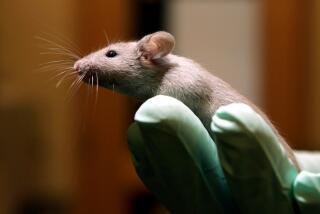Scientists find new source of stem cells
- Share via
Scientists have converted cells from human testes into stem cells that grew into muscle, nerve cells and other kinds of tissue, according to a study published Wednesday in the online edition of Nature.
The stem cells offer another potential alternative to embryonic stem cells for researchers who aim to treat diseases such as diabetes and Parkinson’s by replacing damaged or malfunctioning cells with custom-grown replacements.
Scientists have also derived flexible adult stem cells from skin, amniotic fluid and menstrual blood.
The new cells were created from sperm-making cells obtained from testicular biopsies of 22 men.
They are theoretically superior to traditional embryonic stem cells because they can be obtained directly from male patients and used to grow replacement tissue that their bodies won’t reject, Sabine Conrad of the University of Tuebingen in Germany and her colleagues wrote.
The cells also have an ethical advantage in that they do not require the destruction of human embryos.
Experiments in mice suggested that reproductive cells -- also known as germ cells -- were good candidates for making stem cells because they naturally express low levels of the “pluripotency” genes that make embryonic stem cells so versatile, said Renee A. Reijo Pera, director of the Center for Human Embryonic Stem Cell Research and Education at Stanford University, who was not involved in the study.
The German researchers obtained biopsy samples from men between the ages of 17 and 81. They extracted the individual testicular cells and grew them in laboratory dishes. After about three weeks, some of the cells formed colonies resembling embryonic stem cells, the team reported.
The so-called germline stem cells grew nearly as fast as embryonic stem cells and produced many of the specialized protein markers associated with embryonic stem cells.
Cells from eight of the patients were injected into mice, where they grew into jumbles of tissue that included cartilage, muscle, nerve cells and other building blocks of glands and internal organs, according to the study.
“This would be a great way to produce pluripotent stem cells,” said Kathrin Plath, a researcher at the Broad Center of Regenerative Medicine and Stem Cell Research at UCLA, who was not involved in the study.
But, she said, it remains to be seen whether the germline stem cells are able to form as many kinds of functional cells as embryonic stem cells.
Reijo Pera said germline stem cells do not have a completely blank slate like embryonic stem cells or the reprogrammed skin cells known as induced pluripotent stem cells.
“They have very clear signs of where they came from,” she said.
--







